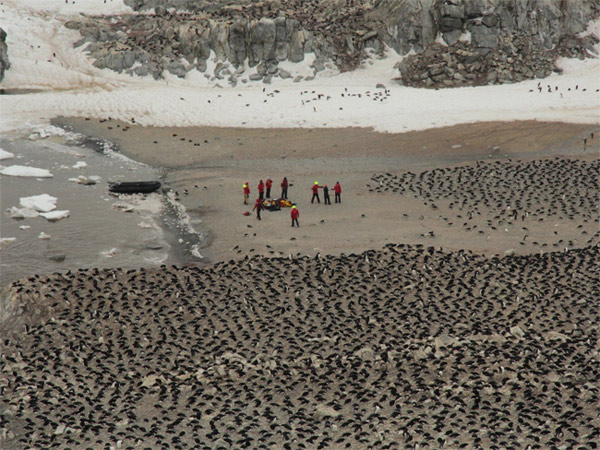Unexpectedly discovered 'super populations' more than 1.5 million penguins never knew in Antarctica
The island's remote location helped penguins thrive.
Recently, scientists have discovered a "super population" Adélie penguin that had never been known before in Antarctica, and this made them really surprised.
Unexpected discovery of "super populations" penguins in Antarctica
Scientists believe that this "super flock" of penguins may not have been affected by the decline in numbers in the past few decades as elsewhere in Antarctica.
Accordingly, this group of penguins was found on a remote island called Danger Island, which is less affected by climate change and impact from humans most than elsewhere in Antarctica.

"Super flock" penguin.(Photo: Tom Hart / Oxford University / Penguinwatch).
The island is located far from the main continent of Antarctic Peninsula and is extremely remote because it is surrounded by thick sea ice.
It is this that makes the penguins become separate from the rest of the world but not until today, we can discover.
Watch video:
Millions of Adélie penguins were discovered on the island Danger.(Source: Fox News.)
"Until recently, Danger Island was not yet known as an important habitat for penguins," said ecologist Heather Lynch of Stony Brook University.
But when scientists noticed strange signs from NASA satellite images of the island, this secret was revealed. An expedition was led by Professor Lynch and a group of scientists to the island.
They were extremely surprised when they set foot on the island with countless bird nests on the ground and then a scene of millions of penguins appeared.

Pictures of penguins from above.(Photo: Thomas Sayre-McCord / WHOI / MIT.)
Danger is a remote island but a safe place with penguins
Using images taken from the overhead of unmanned devices, scientists calculated the total number of penguins living on the island is 751,525 pairs of penguins, more than the rest of the sale. Peninsula.
Professor Michael Polito, an ecologist at Louisiana State University, who directly participated in the study, exclaimed: "It's amazing how many Adélie penguins on this island!".

Researchers use unmanned devices to study.(Photo: Alex Borowicz / Stony Brook University).
In recent decades, scientists believe that the number of Adélie penguins has steadily decreased due to the effects of climate change and humans, but this new finding has caused them to change their views. this.
It is a remote location, isolated from the rest of the world that helps penguins grow stronger than other parts of Antarctica and protect them under negative impacts from the environment as well as humans. .

Rachael Herman / Stony Brook University / Louisiana State University
Professor Michael Polito, an ecologist at Louisiana State University said:
"Danger not only holds the largest population of Adélie penguins in Antarctic Peninsula, but the bird is not affected by the decline in numbers like East Antarctic Peninsula, which is affected by climate change."
Dr. Tom Hart added: "What we see in this Western Antarctic Peninsula is in stark contrast to the Adélie penguin of the Eastern Antarctic Peninsula."
This suggests that penguins are better adapted to less human-impacted environments and that environmentalists need to protect the Weddell Sea area, which is home to the remote Danger Island.

Michael Polito / Louisiana State University
" This exciting discovery shows us that there are many wonderful things we still have to study about the symbolic animals of ice . " The head of the program Rod Downie said.
"But we must also strengthen the protection of the water environment in the Antarctic waters to protect the Adélie penguin from the two dangers of overfishing and climate change."
The study is published in the scientific journal Scientific Reports.
- Approaching a population of 9,000 emperor penguins
- Why do hundreds of Antarctic penguins turn into mummies?
- New discovery about the existence of Antarctic penguins
- Discovered a rare species of penguin in Antarctica
- The 'mysterious nest' of 1.5 million penguin humans has never known
- Discover interesting things about penguins
- Emperor penguins face extinction
- The penguin bunched up to warm the cubs
- Thousands of emperor penguins in Antarctica disappeared after a night
- Hundreds of penguin corpses were discovered in Brazil
- Penguins die in mass in Antarctica
- The secret of not freezing of Antarctic penguins
 Surprised: Fish that live in the dark ocean still see colors
Surprised: Fish that live in the dark ocean still see colors Japan suddenly caught the creature that caused the earthquake in the legend
Japan suddenly caught the creature that caused the earthquake in the legend A series of gray whale carcasses washed ashore on California's coast
A series of gray whale carcasses washed ashore on California's coast Compare the size of shark species in the world
Compare the size of shark species in the world Penguins jump from 15m high cliffs because of hunger
Penguins jump from 15m high cliffs because of hunger  Are thousands of penguins dying in Antarctica due to bird flu?
Are thousands of penguins dying in Antarctica due to bird flu?  Detection of H5N1 avian influenza virus on penguin carcasses in Antarctica
Detection of H5N1 avian influenza virus on penguin carcasses in Antarctica  Penguins are being less faithful because of... climate change
Penguins are being less faithful because of... climate change  African penguins are at risk of extinction due to noise pollution
African penguins are at risk of extinction due to noise pollution  Find out why penguins 'stopped' evolution
Find out why penguins 'stopped' evolution 